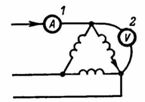Calculation of phase and line values of three-phase current
A three-phase generator has three single-phase independent stator windings whose starts and ends are displaced by 120 el respectively. hail, or by splitting into 2/3 poles, ie. with 2/3 the distance between the centers of the opposite poles (Fig. 1). A single-phase alternating current is generated in each of the three windings. The currents of a single-phase winding are mutually offset by 120 el. hail, that is, for 2/3 of the period. Thus, a three-phase current is three single-phase currents shifted in time by 2/3 of the period (120 °).
At any instant of time, the algebraic sum of the three instantaneous: values of a. etc. c. the individual phases are zero. Therefore, instead of six terminals (for three independent single-phase windings), only three terminals are made on the generator, or four when the zero point is indicated. Depending on how the individual phases are connected and how they are connected to the network, a star or delta connection can be obtained.
The beginnings of the coils are indicated below with the letters A, B, C, and their ends with the letters X, Y, Z.
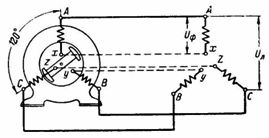
Rice. 1. Three-phase generator
a) Star connection.
When connected in a star, the ends of the phases X, Y, Z (Fig. 2) are connected and the connection node is called the zero point. The node may have a terminal — the so-called neutral wire (Fig. 272), shown by a dashed line — or be without a terminal.
When connected to a star with a neutral wire, you can get two voltages: line voltage Ul between conductors of separate phases and phase voltage Uf between phase and neutral conductor (Fig. 2). The relationship between line and phase voltage is expressed as follows: Ul = Uph ∙ √3.
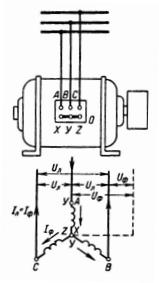
Rice. 2. Star connection
The current that flows in the wire (network) also flows through the phase winding (Fig. 2), i.e. Il = Iph.
b) Connection in a triangle.
The connection of the phases in a triangle is obtained by connecting the ends and the beginning of the phases according to fig. 3, i.e. AY, BZ, CX. In such a connection, there is no neutral conductor and the phase voltage is equal to the line voltage between the two conductors of the line Ul = Uf. However, the current in the line Il (mains) is greater than the current in the phase Iph, namely: Il = Iph ∙ √3.
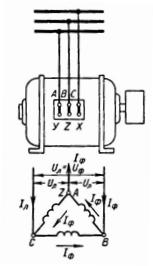
Rice. 3. Delta connection
In a three-phase system, at any moment, if the current in one coil flows from end to end, then in the other two it flows from end to end. For example, in FIG. 2 in the middle coil AX runs from A to X and in the outer coils from Y to B and from Z to C.
The diagram (Fig. 4) shows how three identical windings are connected to the motor terminals in star or delta.
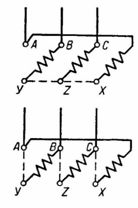
Rice. 4. Connecting windings in star and delta
Calculation examples
1. A generator with a connected stator winding as shown in fig. 5 circuit, at a mains voltage of 220 V, it supplies three identical lamps with a resistance of 153 Ohm with current.What voltage and current does each lamp (Fig. 5) have?
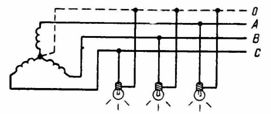
Rice. 5.
According to the connection, the lamps have a phase voltage Uf = U / √3 = 220 / 1.732 = 127 V.
Lamp current If = Uph / r = 127/153 = 0.8 A.
2. Determine the circuit for turning on three lamps in fig. 6, the voltage and current of each lamp with a resistance of 500 Ohm, connected to a mains supply with a mains voltage of 220 V.
Lamp current I = Ul / 500 = 220/500 = 0.45 A.
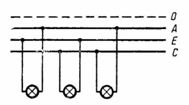
Rice. 6.
3. How many volts should voltmeter 1 show if voltmeter 2 shows a voltage of 220 V (Fig. 7)?
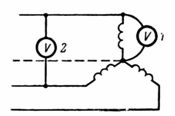
Rice. 7.
Phase voltage Uph = Ul / √3 = 220 / 1.73 = 127 V.
4. What current does ammeter 1 indicate if ammeter 2 indicates a current of 20 A when connected in a delta (Fig. 8)?

Rice. eight.
If = Il / √3 = 20 / 1.73 = 11.55 A.
In a delta connection, the current in the consumer's phase is less than in the line.
5. What voltage and current will be shown by measuring devices 2 and 3 connected to the phase, if the voltmeter 1 shows 380 V, and the resistance of the phase of the consumer is 22 Ohm (Fig. 9)?

Rice. nine.
Voltmeter 2 shows the phase voltage Uf = Ul / √3 = 380 / 1.73 = 220 V. and ammeter 3 shows the phase current If = Uf / r = 220/22 = 10 A.
6. How many amperes does the ammeter 1 show if the resistance of one phase of the consumer is 19 ohms with a voltage drop across it of 380 V, which is shown by the voltmeter 2, connected according to fig. ten.
Rice. ten.
Phase current Iph = Uph / r = Ul / r = 380/19 = 20 A.
The user current according to the reading of the ammeter 1 Il = Iph ∙ √3 = 20 ∙ 1.73 = 34.6 A. (The phase, i.e. the side of the triangle, may represent the winding of a machine, transformer or other resistance.)
7. Asynchronous motor in fig.2 has a star-connected winding and is connected to a three-phase network with a network voltage Ul = 380 V. What will be the phase voltage?
The phase voltage will be between the zero point (terminals X, Y, Z) and any of the terminals A, B, C:
Uph = Ul / √3 = 380 / 1.73 = 219.4≈220 V.
8. The winding of the induction motor of the previous example is closed in a triangle by connecting the clamps of the motor shield according to fig. 3 or 4. An ammeter connected to the line conductor shows a current Il = 20 A. What current flows through the stator winding (phase)?
Line current Il = Iph ∙ √3; If = Il / √3 = 20 / 1.73 = 11.56 A.

